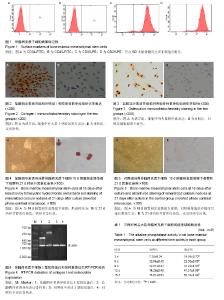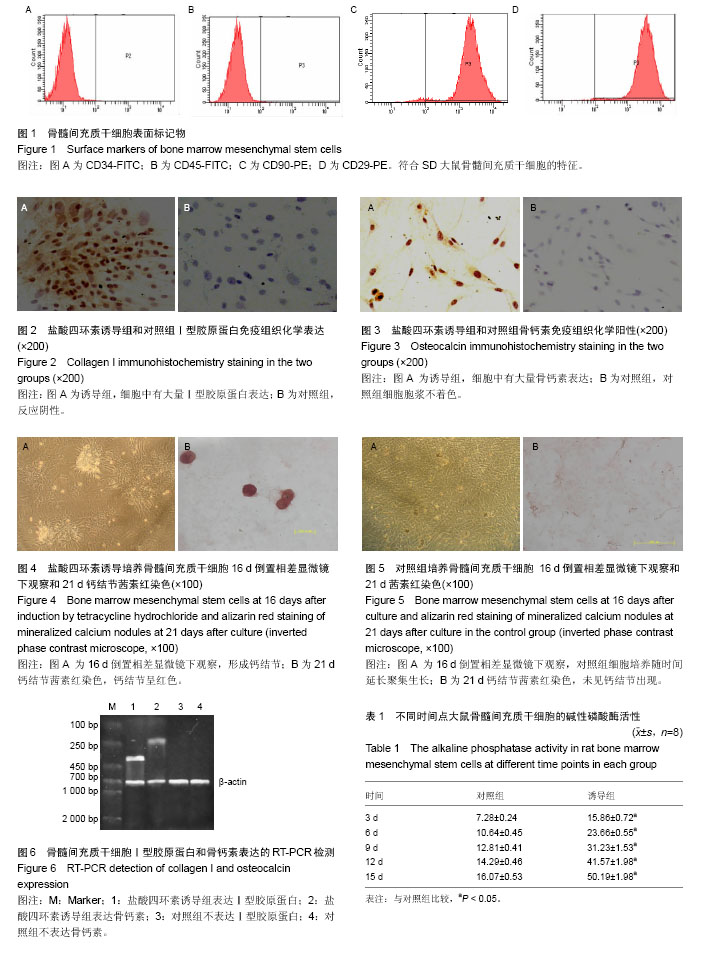| [1] Pittenger MF,Mackay AM,Beck SC,et al. Multilineage potential of adult human mesenchymal stem cells. Science.1999; 284: 143-147.[2] Derval N, Barandon L, Dufourcq P, et al.Epicardial deposition of endothelial progenitor and mesenchymal stem cells in a coated muscle patch after myocardial infarction in a murine model.Eur J Cardiothorac Surg.2008;34:248-254.[3] Song K, Yang Z, Liu T, et al.Fabrication and detection of tissue-engineered bones with bio-derived scaffolds in a rotating bioreactor. Biotechnol Appl Biochem. 2006;45(Pt 2): 65-74.[4] 殷晓雪,陈仲强,郭昭庆,等.人骨髓间充质干细胞定向分化为成骨细胞及其鉴定[J]. 中国修复重建外科杂志,2004,18(2): 88-91.[5] Riew KD,Wright NM,Cheng S,et al.Induction of bone formation using a recombinant adenoviral vector carrying the human BMP-2 gene in a rabbit spinal fusion model. Calif Tissue Int.1998;63(4):357-360.[6] Locklin RM,Williamson MC,Beresfird JN, et al. In vitro effects of growth factors and dexamethasone on rat marrow stromal cells.Clin Orthop Relat Res.1995;(313):27-35.[7] Golub LM, Lee HM, Lehrer G ,et al.Minocycline reduces gingival collagenolytic activity during diabetes:preliminary observations and a proposed new mechanism of action. J Periodontal Res.1983;18(5):516-526.[8] Golub LM,Ramamurthy NS,McNamara TF,et al.Tetracyclines inhibit tissue collagenase activity:a new mechanism in the treatment of periodontal disease.J Periodontal Res.1984;19: 651-655.[9] Golub LM, Goodson JM, Lee HM,et al. Locally and lowdose systemically administered tetracycline inhibitt issue collagenase activity:potential new approaches in the treatment of periodontal disease.J Periodontol.1985;56: 93-97.[10] Golub LM,Wolf M,Lee HM,et al.Further evidence that Tetracyclines inhibit collagenase activity in human crevicular fluid and from other mammalian source.J Periodont Res.1985; 20:12 -23. [11] 陈旭,杨志明,解慧琪,等.WO-1对成骨细胞的生物学效应研究[J].中国修复重建外科杂志,2005,19(10):822-825[12] 李莉,黄永灿,常丽,等.盐酸四环素缓释微球的制备[J].华西药学杂志,2008,23(4):391-393.[13] 张珏,陈晓和,李莉,等.盐酸四环素缓释微球对大鼠成骨细胞活性的影响[J].华西药学杂志,2010,25 (1):1-3.[14] 张珏,邓媛媛,曾富佳.盐酸四环素缓释微球对成骨细胞增殖作用的研究[J].中国民族民间医药杂志,2013,22(18):19-20.[15] 隋珂. DDR2基因缺失对小鼠骨髓间充质干细胞生物学特性影响的研究[D].陕西:第四军医大学(西安),2014:13.[16] Undale AH,Westendorf JJ,Yaszemski MJ,et al.Mesenchymal stem cells for bone repair and metabolic bone diseases. Mayo Clin Proc. 2009;84(10):893-902.[17] Wagner W,Wein F,Seckinger A,et al.Comparative characteristics of mesenchymal stemcells from human bone marrow,adipose tissue,and umbilical cord blood.Exo Hematlo. 2005 ;33(11):1402-1416. [18] 柯金勇,林艳娟.骨髓间充质干细胞生物学特性的研究[J].医学综述,2008,14(15):2241-2244[19] 马威,时惠英,刘宝林,等.成骨细胞在微弧氧化处理后纯钛表面的附着、增殖及ALP活性[J].实用口腔医学杂志,2005,21(1):106-110.[20] Alborzi A,Mac K,Glackin CA,et al.Endochondral and intramembranous fetal bone development:osteoblastic cell prolifcration and expression of alkaline phosphatasc, intwist,and histone H4.J Craniofac Gent Dev Biol.1996;6(2): 94-106.[21] 段智霞,郑启新,郭晓东,等.骨形成蛋白2活性多肽体外定向诱导骨髓间充质干细胞向成骨方向分化的剂量依赖性研究[J].中国修复重建外科杂志,2007,21(10):1118-1121.[22] Roehlecke C,Witt M,Kasper M,et al.Synergis tic effect of titanium alloy and collagen type I on cell adhes ion, proliferation and differentiation of os teoblas t-like cells.Cells Tis sues Organs.2001;168(3):178-187.[23] 李灵芝,翁玲玲,张文亮.四环素-哌嗪雌酚酮对小鼠骺板I型胶原表达的影响[J].四川大学学报:医学版,2003,34(1):86-88.[24] 祁洁.骨组织工程中成骨细胞与生物材料相互作用的分子机制[D] .成都:四川大学,2005.[25] 马慧萍,贾正平,陈克明,等.含淫羊藿总黄酮大鼠血清对成骨细胞发育的影响[J].中国中药杂志,2008,33(8): 928-9301[26] Gunberg CM, Nishimoto SK.Vitamin K-Dependent Proteins of Bone and Cartilage. Dynamics of Bone and Cartilage Metabolism. San Diego, Academic Press.1999:45-53.[27] 周昆鹏,陈晓禾,常丽,等.成骨细胞条件培养液对BMSCs的诱导分化作用[J].中国修复重建外科杂志,2009,23(2):145-150. |

